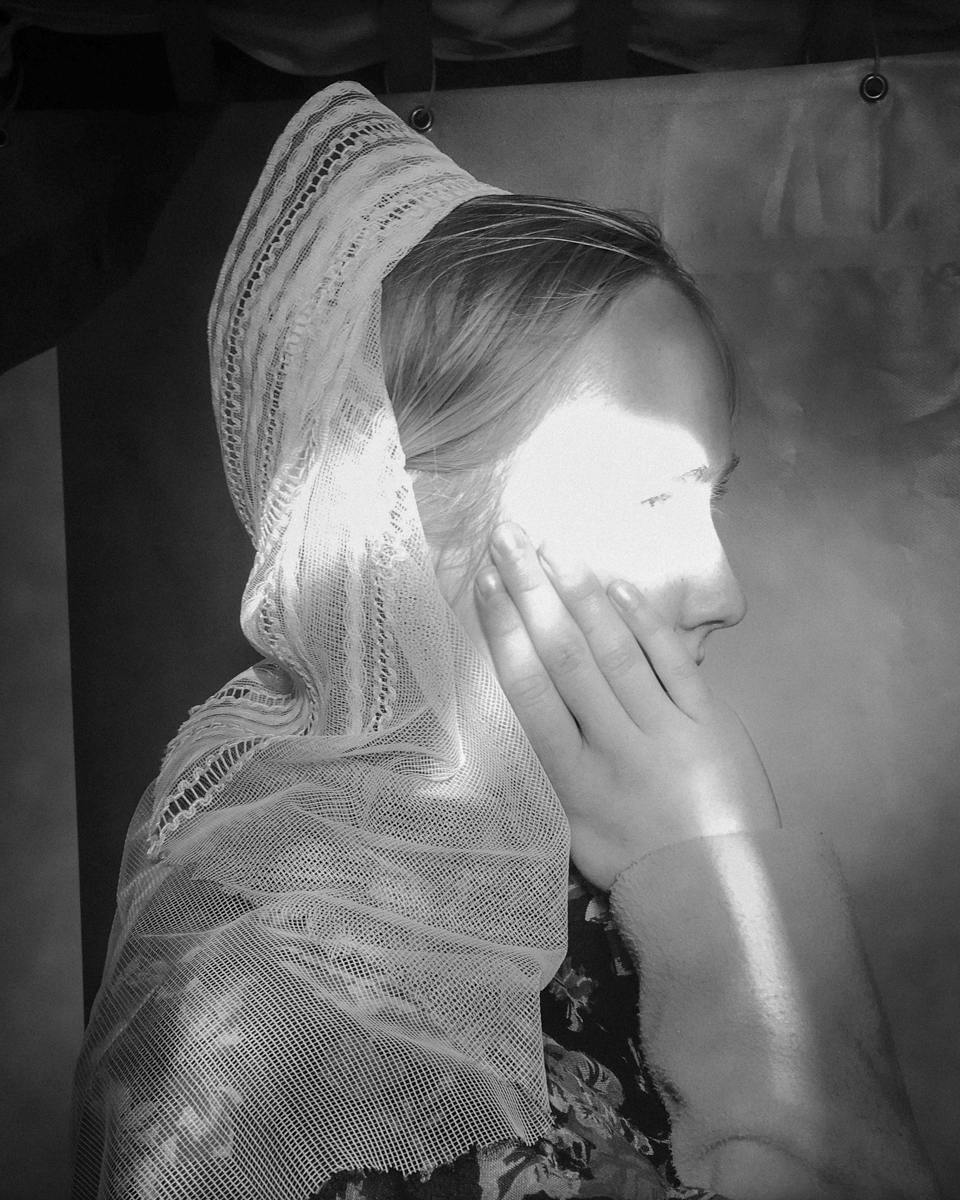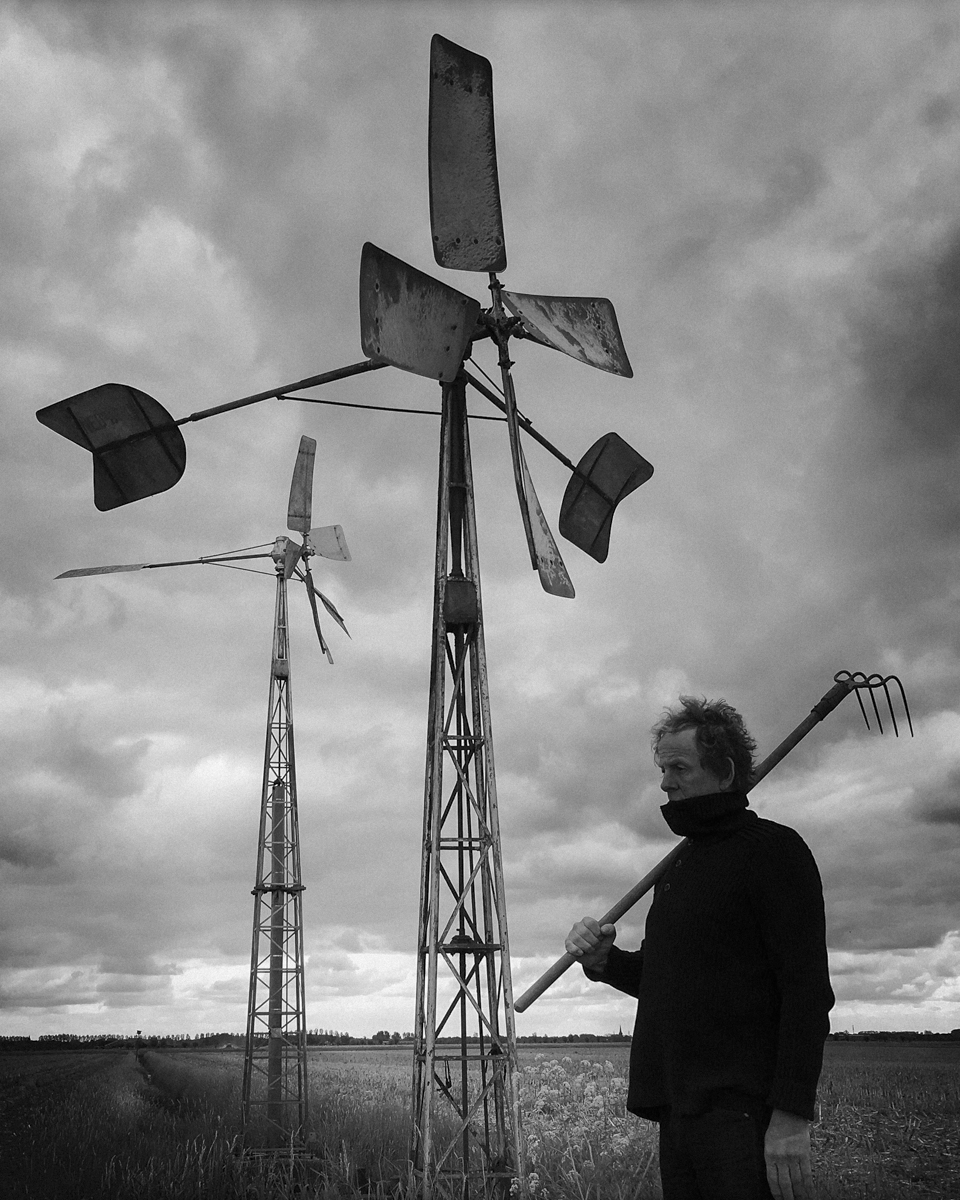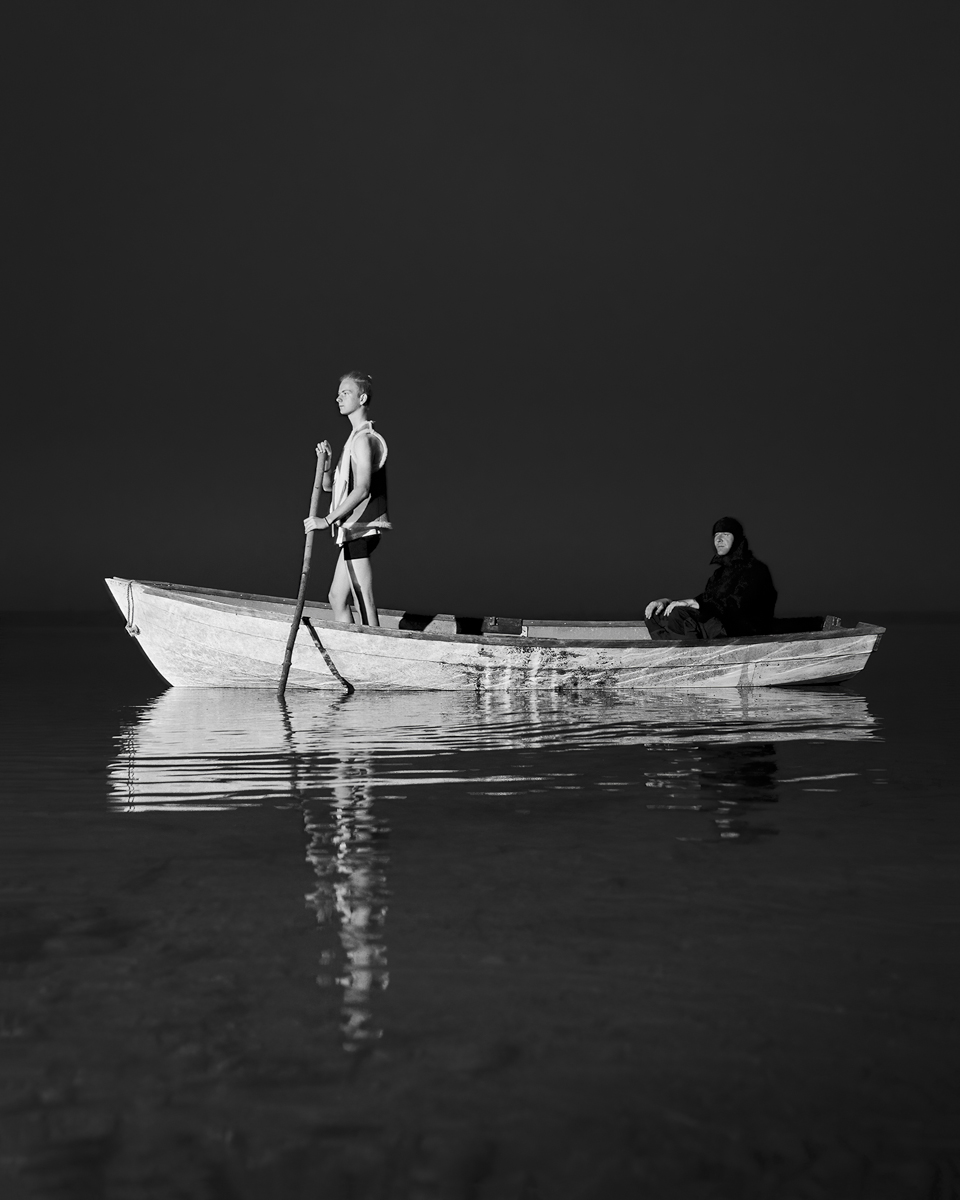Wiesje and Trijntje come from the Netherlands. I discovered Wiesje because she ended up in the finals of Lensulture 2019 Photography Awards with her recent project Nest. Wiesje also works with her daughter Trijntje, with whom she has always collaborated since she was too little to hold a camera. She has been an inspiration and a support during the years.
In this mother-daughter work, nature and imagination are central and through Nest they create a world based on real life experiences, inspiration from literature, film and performative arts. Due to the lack of colour in the photography, they say that they sketch ‘existentialist black and white images’.




I asked both of them some questions on their work and life.
Tell us more about your background:
Wiesje: As a child, my father made me enthusiastic about photography. He built a darkroom in our attic. Later there was a teacher at my high school who saw my talents and encouraged me to go to art school. I studied at the art academy Sint Joost in Breda, NL, in the 90s. Analogue photography was my field of study. There I met fellow student Mischa and we started a relationship. Later he became the father of my children. During my studies I made a lot of, so to say; ‘flying hours’, regarding to photography. From journalism, studio, documentary, portrait to autonomous self-initiated projects. I have worked for newspapers, museums, design agencies and made images for annual reports of various companies. After a number of years of analogue assignments in the field, digital photography became more and more popular. I switched from analog to digital. It made the work faster and there was more competition. The commissions interested me less and less because of the contentlessness and I became more ambitious in the world of contemporary art photography. I wanted to tell my own stories to the world. By entering into collaborations with fellow artists, cultural institutions, art galleries and subsidy applications, I was given the opportunity to grow within my photography. I published several photobooks, went on artist in residences and made multiple exhibitions. After working within this field for a number of years, I was asked to teach at the art academy in Maastricht and Tilburg. By working with students, I have become aware of how important it is to stimulate children and young people in making visual work. My own children, daughter Trijntje (15) and son Lytse (18), became and are as natural a part of our creative process as artists. They saw what their mom and dad did and were taken in. Holding the flashlight, coming along on an Artist in Residence, thinking and creating along with us. With the project Nest, my daughter and I want to show that you can transform universal feelings and things you experience into visual art.
When did you start taking photographs and what camera did you use?
Wiesje: I started taking photographs when I was 8 years old and used an analogue Pentax Asahi. When I studied photography, I used Leica M, Nikon, Olympus PEN and TRIP, Konica Hexar, Pentax 6×7, Mamiya 6×7, Rolleiflex 6×6, Yashica, Hasselblad 6×6, Fujifilm. Now I’m using my digital Nikon with a 35 and 60 mm, my Iphone and a Fujifilm XT100.




How did you develop your style? Who inspired you?
Wiesje: By working together on a regular basis with fellow artists and visiting many exhibitions I get inspired. Those inspirations are not only photography based. I also get a lot of inspiration by literature, performing arts, film and music. Artist like, Ingmar Bergman, Paolo Ventura, Federico Fellini, Jaques Tati, Hergé, Sally Mann, Bruce Davidson, Teun Hocks, Pablo Neruda, Astrid Lindgren. Also, composers like Arvo Part, Purcell, Bach give me a sort of ‘workflow’. Sometimes I don’t want to look at work of other artist because it influences me too much. I want to stay as close as possible to my own ‘language’. I got a lot of inspiration of shopping in secondhand shops and flea markets. Every object that catches my eye is telling a kind of story. I want to visualize that story by discussing it with my daughter or other fellow artists.
How do you approach people when you photograph them?
Wiesje: When I see a person, who characterizes a certain role within the Nest project I speak to that person and explain step by step why and how I would like to work together. I show previously taken pictures to make the atmosphere in which I work clear. Whoever I photograph always gets a print or email with the photo we’ve been working on.




How do you find inspiration? Where do the ideas for your projects come from?
Wiesje: By visiting local museums in the area where we are photographing. The surroundings and locations are very decisive for the work. Ideas come from reflecting on life’s events. Also, by observing well and ‘magnifying ‘it. My inner motivations usually send me to something I want to depict. I feel the need to represent what’s in my head and heart. The stories and ideas are close to me and the people around me. A couple of years ago I realized a project called Mimus. I asked circus artists from small family circuses all over Europe to represent my emotions behind the scenes of their circus. This by means of certain poses that I observed and recorded earlier. The artists featured in the story I wanted to tell as an artist. This because my father used to have a small circus and as a child I sometimes had to play a role if someone from the audience didn’t want to participate.
What is the element that you value the most when taking a photo?
Wiesje: Working with fine people and capturing transience. Everything of value drives to disappear but through photography you can capture it.




How long does it take to finish the project you have in mind?
Wiesje: It is an ongoing project. Time is not important or an issue in this project. It flows like a river. In a natural way it finds its way. It is important that it grows and is evaluated and presented to the public. That is why publications like this are very nice and important to us.
We show with light and shadow the world that is in your head and heart and the battle between them.
You told me that your daughter has always played a big part in your work. How did you Trijntje start working with your mum?
Trijntje: While playing, I became part of the project. I started to watch and think more and more and soon a cooperation developed. I also had an opinion on the way we worked together. Ever since I was a child pictures were taken of me and my brother, that is what you get with two parents as photographers. With Nest I got involved with the images. Our family is all part of the project, but I started to think along out of curiosity and in a playful way my sketches and texts also became part of the project. My mother and I are very sensitive to atmospheres and each other. We really understand each other very well, which is a huge gift. In this project we both develop alongside each other but always connected! I grew up together with this project, it is a great source of creativity and it developed together with my mother. It is also a great source of reflection on myself and my childhood on how I have transformed and grew up. A source that reflects as a silent light.




What made you approach photography? What camera do you prefer?
Trijntje: I don’t photograph so much, lately I’m mainly busy with music, theatre and lyrics, also in the context of Nest. When I photograph, I prefer to do it analogue with an Olympus Pen or Trip. My mother introduced me to the darkroom. I like to work with loud music. I like working concentrated and experimenting in the darkroom. It remains magical to experience the complete development of a photograph.
How do you think photography has changed between generations?
Trijntje; I think photography and especially the way of thinking of- and looking at – the world has changed within my generation! My generation will often seem much more self-centered. Because of the way one deals with photography, it loses its magic.




Are you more social media oriented compared to your mother?
Trijntje; Haha, funny you asked. My mother is much more into social media than I am, because I threw away all my social media after my first six months of high school. I was 13 years old at the time and I liked social media a lot, but I noticed it changed my way of observing and thinking. I get very sad from people who are always walking around with their heads bowed and looking at their phones while there is so much beauty around us. In the end, social media is all about showing who you are and what you’re not, what you do, how amazingly perfect you are, how well you fit into that social mould that disgusts me so much. Especially as a developing adolescent, I felt suffocated in all those social media, it’s all hard enough without them. I wanted to be independent. So, I replaced my smartphone for an old Nokia. I do what I stand for. You can only start as early as possible. I’m happy every day that I no longer carry the burden of too many stimuli. I’m sometimes insecure, afraid of what other people think. That’s why I can sometimes get in the way of myself. This is caused by an imbalance between my head and heart. I am a worrier but refuse to let too many stimuli influence me. I’m different from my peers. When everyone is on their phones at school break and no one wants to talk, I just read the newspaper or a book. I shut myself off but find peace in this. Usually I find people to talk to and laugh with. Classmates sometimes find me hard to place, because I don’t let myself easily be categorized.
My mother is mainly busy on social media for her work. I can be pretty hard on her if she’s busy with her phone too often. We often talk about it and try to take each other into consideration as much as possible. My mother didn’t grow up in a time when everyone is busy with their phone. She is older and has a network of people who deal with social media more responsibly than my peers. There are no rules. At my age, you want to discover all the rules and boundaries and go beyond them. But it’s not a physical world, the world in your mobile. Due to the lack of eye contact, there is more likely to be a lack of respect or humanity. You don’t say or do things in front of someone. It feels easier to be able to do whatever you want. Nobody will address you directly about it.
I want to be as independent as possible in order to grow. Not being stuck on time, stuck in your head, but living closer to yourself and your heart.




Tell me more about your background.
Trijntje: I am Trijntje Keijser and I live in Breda NL, together with my brother (Lytse Keijser, 18 years old) my father (Mischa Keijser, 45 years old, artist) my mother (Wiesje Peels, 44 years old, artist) and her boyfriend (Reinout van den Bergh, 63 years old, artist). I have a great love and interest for music, visual arts, theatre, film (preferably art house), books and poetry. I also find history very interesting. I value nostalgia. I can become happy from an old enamel jug with rust stains. Vintage clothes, creaking houses, faded pictures, the smell of smoke and the light of oil lamps or candles give me the feeling of being looser of time. The simple life. I feel connected to the sea and the sun. Sailing gives me an intense feeling of being comfortable. When I sail I am happy. At home I can dream of lighthouses and of salt in your hair. The wind that takes all your thoughts and washes everything clean with salt and sand.
Since the age of six I have been taking music lessons with my guitar teacher Jos who lives on our street. I love my guitar and prefer to play with my eyes closed. When I’m in the flow the music takes you with it! Then your heart opens up and you are freer and feel lighter. I always want to make music. Later on I’m going to use it in my work as a kind of ‘connecting home’ for other forms of art like literature, visual arts, film, theatre and much more. Since a couple of months, I also take accordion lessons. I think the accordion is a beautiful instrument, just like the guitar! When I play it feels like my heart gets lungs. I’m at Michael College, a Waldorf school. School is more of an obligation to me than something fun. I can’t wait to go to college where I can really do and make things that interest me. Learning by falling and getting up again.I can deeply enjoy and be moved by small and big things. Sometimes I can be overwhelmed in the moment. Be empathetic, see a lot, hear a lot and love people. Sometimes I can distrust people. I can colour everything with my imagination. Often, I close my eyes, because looking is tiring and I feel a lot. I am already quite big but also very small. I am growing. I observe and try to put this into words to create an image of a situation and this world we live in, just like my mother.




Let’s talk about your project “Nest”. Why did you choose black and white?
Wiesje; The project bears the name Nest because we work from ‘our Nest’. Family, familiarity and playing together are the main priorities. I think that color is a way of showing ‘reality’, black and white the ‘truth’. I want the images to appeal to your imagination. I don’t intend to make a connection with reality.
What is the story behind each photo?
The photographs radiate an atmosphere that appeals to the imagination. The texts of Trijntje which can be read on our website support that atmosphere.




What are the future plans for both of you?
Wiesje; Nest will be continuing. No idea how it’s going to develop. We would like to do more with film and installation. Our wish is to exhibit more and respond to exhibition spaces with installations, text, film and performance. I think it’s a great gift to work with my daughter and other loved ones, to play and to imagine what motivates us.
Trijntje; I want to go to Theater school after high school. After that I would like to continue my studies to a higher theatre education or to the conservatory. We’ll see how that goes. I want to make a combination between music, theatre, text, visual art, film and much more. Besides Nest, my mother and I will make more projects together, because that feels good!
For more Photography articles, read here.
Follow @positive_mag on twitter for the last updateshttps://www.positive-magazine.com/wiesje-trijntje-nest/?utm_source=rss&utm_medium=rss&utm_campaign=wiesje-trijntje-nest

